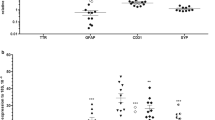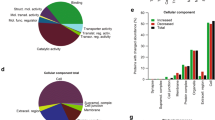Abstract
Purpose. To determine the importance of PEPT2 in the uptake of glycylsarcosine (GlySar) and 5-aminolevulinic acid (5-ALA) in mouse choroid plexus whole tissue.
Methods. Uptake studies were performed in bicarbonate artificial cerebrospinal fluid buffer using choroid plexuses isolated from PEPT2+/+ and PEPT2-/- mice. [14C]GlySar and [14C]5-ALA were studied as a function of temperature, concentration, potential inhibitors, and low sodium conditions.
Results. PEPT2-/- mice exhibited a 90% reduction in GlySar uptake (p < 0.001) and a 92% reduction in 5-ALA uptake (p < 0.001) as compared to wild type animals. At 4°C (vs. 37°C), GlySar uptake was reduced by 95% in PEPT2+/+ mice; no difference was observed in null animals. Unlabeled GlySar inhibited the uptake of [14C]GlySar in PEPT2+/+ mice (p < 0.01); self-inhibition did not occur in PEPT2-/- mice. GlySar demonstrated saturable uptake in PEPT2+/+ mice (Vmax = 16.4 pmol mg−1 min−1, Km = 70 μM, Kd = 0.014 μl mg−1 min−1), however, uptake was linear in PEPT2-/- mice (Kd = 0.023 μl mg−1 min−1). Low sodium buffer (1 mM) resulted in 75% and 59% reductions, respectively, in GlySar (p < 0.001) and 5-ALA (p < 0.01) uptake in PEPT2+/+ mice; no differences were observed in PEPT2-/- mice. Overall, about 90-95% of the choroid plexus uptake of GlySar and 5-ALA was mediated by PEPT2, with about 5-10% of the residual uptake occurring by nonspecific mechanisms.
Conclusions. The results demonstrate that PEPT2 is the only transporter responsible for the choroid plexus uptake of GlySar and 5-ALA. They also suggest a role for PEPT2 in the clearance of dipeptides and endogenous peptidomimetics from cerebrospinal fluid.
Similar content being viewed by others
REFERENCES
E. M. Wright. Transport processes in the formation of the cerebrospinal fluid. Rev. Physiol. Biochem. Pharmacol. 83:3-34 (1978).
M. Bradbury. The Concept of a Blood-Brain Barrier, John Wiley & Sons, New York, 1979, pp. 38-60.
D. Herrera-Ruiz and G. T. Knipp. Current perspectives on established and putative mammalian oligopeptide transporters. J. Pharm. Sci. 92:691-714 (2002).
W. Liu, R. Liang, S. Ramamoorthy, Y.-J. Fei, M. E. Ganapathy, M. A. Hediger, V. Ganapathy, and F. H. Leibach. Molecular cloning of PEPT2, a new member of the H +/peptide cotransporter family, from human kidney. Biochim. Biophys. Acta 1235: 461-466 (1995).
H. Daniel and M. Herget. Cellular and molecular mechanisms of renal peptide transport. Am. J. Physiol. 273:F1-F8 (1997).
U. V. Berger and M. A. Hediger. Distribution of peptide transporter PEPT2 mRNA in the rat nervous system. Anat. Embryol. 199:439-449 (1999).
S. Choudhuri, N. J. Cherrington, N. Li, and C. D. Klaassen. Constitutive expression of various xenobiotics and endobiotic transporter mRNAs in the choroid plexus of rats. Drug Metab. Dispos. 31:1337-1345 (2003).
A. Novotny, J. Xiang, W. Stummer, N. S. Teuscher, D. E. Smith, and R. F. Keep. Mechanisms of 5-aminolevulinic acid uptake at the choroid plexus. J. Neurochem. 75:321-328 (2000).
C. Shu, H. Shen, N. S. Teuscher, P. J. Lorenzi, R. F. Keep, and D. E. Smith. Role of PEPT2 in peptide/mimetic trafficking at the blood-cerebrospinal fluid barrier: Studies in rat choroid plexus epithelial cells in primary culture. J. Pharmacol. Exp. Ther. 301: 820-829 (2002).
N. S. Teuscher, A. Novotny, R. F. Keep, and D. E. Smith. Functional evidence for the presence of PEPT2 in rat choroid plexus: Studies with glycylsarcosine. J. Pharmacol. Exp. Ther. 294:494-499 (2000).
N. S. Teuscher, R. F. Keep, and D. E. Smith. PEPT2-mediated uptake of neuropeptides in rat choroid plexus. Pharm. Res. 18: 807-813 (2001).
S. M. Ocheltree, H. Shen, Y. Hu, J. Xiang, R. F. Keep, and D. E. Smith. Mechanisms of cefadroxil uptake in the choroid plexus: Studies in wild-type and PEPT2 knockout mice. J. Pharm. Exp. Ther. 308:462-467 (2004).
H. Shen, D. E. Smith, R. F. Keep, J. Xiang, and F. C. Brosius III. Targeted disruption of the PEPT2 gene markedly reduces dipeptide uptake in choroid plexus. J. Biol. Chem. 278:4786-4791 (2003).
N. S. Teuscher, H. Shen, C. Shu, J. Xiang, R. F. Keep, and D. E. Smith. Carnosine uptake in rat choroid plexus primary cell cultures and choroid plexus whole tissue from PEPT2 null mice. J. Neurochem. 89:375-382 (2004).
T. Yamashita, S. Shimada, W. Guo, K. Sato, E. Kohmura, T. Hayakawa, T. Takagi, and M. Tohyama. Cloning and functional expression of a brain peptide/histidine transporter. J. Biol. Chem. 272:10205-10211 (1997).
I. Rubio-Aliaga, I. Frey, M. Boll, D. Groneberg, H. M. Eichinger, R. Balling, and H. Daniel. Targeted disruption of the peptide transporter Pept2 gene in mice defined its physiological role in the kidney. Mol. Cell. Biol. 23:3247-3252 (2003).
F. Döring, J. Walter, J. Will, M. Föcking, M. Boll, S. Amasheh, W. Clauss, and H. Daniel. Delta-aminolevulinic acid transport by intestinal and renal peptide transporters and its physiological and clinical implications. J. Clin. Invest. 101:2761-2767 (1998).
S. R. Ennis, A. Novotny, J. Xiang, P. Shakui, T. Masada, W. Stummer, D. E. Smith, and R. F. Keep. Transport of 5-amino-levulinic acid between blood and brain. Brain Res. 959:226-234 (2003).
R. F. Keep and J. Xiang. N-system amino acid transport at the blood-CSF-barrier. J. Neurochem. 65:2571-2576 (1995).
J. Arakawa and A. Hara. Effect of 5-(N,N-Dimethyl)-amiloride, a specific inhibitor of Na(+)/H(+) exchanger, on the palmitoyl-L-carnitine-induced mechanical and metabolic derangements in the isolated perfused rat heart. Pharmacol. 59:239-248 (1999).
L. Mirossay, A. Mirossay, E. Kocisova, I. Radvakova, P. Miskovsky, and J. Mojzis. Hypericin-induced phototoxicity of human leukemic cell line HL-60 is potentiated by omeperazole, an inhibitor of H+ K+-ATPase and 5′-(N,N-dimethyl)-amiloride, an inhibitor of Na+ /H+ exchanger. Physiol. Res. 48:135-141 (1999).
H. Daniel. Function and molecular structure of brush border membrane peptide/H+ symporters. J. Membr. Biol. 154:197-203 (1996).
I. Rubio-Aliaga and H. Daniel. Mammalian peptide transporters as targets for drug delivery. Trends Pharmacol. Sci. 23:434-440 (2002).
A. Gorchein and R. Webber. δ-Aminolevulinic acid in plasma, cerebrospinal fluid, saliva and erythrocytes: Studies in normal, uraemic and porphyric subjects. Clin. Sci. 72:103-112 (1987).
K. Sakata, T. Yamashita, M. Maeda, Y. Moriyama, S. Shimada, and M. Tohyama. Cloning of a lymphatic peptide/histidine transporter. J. Biochem. 356:53-60 (2001).
S. M. Ocheltree, R. F. Keep, H. Shen, D. Yang, B. A. Hughes, and D. E. Smith. Preliminary investigation into the expression of proton-coupled oligopeptide transporters in neural retina and retinal pigment epithelium (RPE): Lack of functional activity in RPE plasma membranes. Pharm. Res. 20:1364-1372 (2003).
Author information
Authors and Affiliations
Rights and permissions
About this article
Cite this article
Ocheltree, S.M., Shen, H., Hu, Y. et al. Role of PEPT2 in the Choroid Plexus Uptake of Glycylsarcosine and 5-Aminolevulinic Acid: Studies in Wild-Type and Null Mice. Pharm Res 21, 1680–1685 (2004). https://doi.org/10.1023/B:PHAM.0000041465.89254.05
Issue Date:
DOI: https://doi.org/10.1023/B:PHAM.0000041465.89254.05




